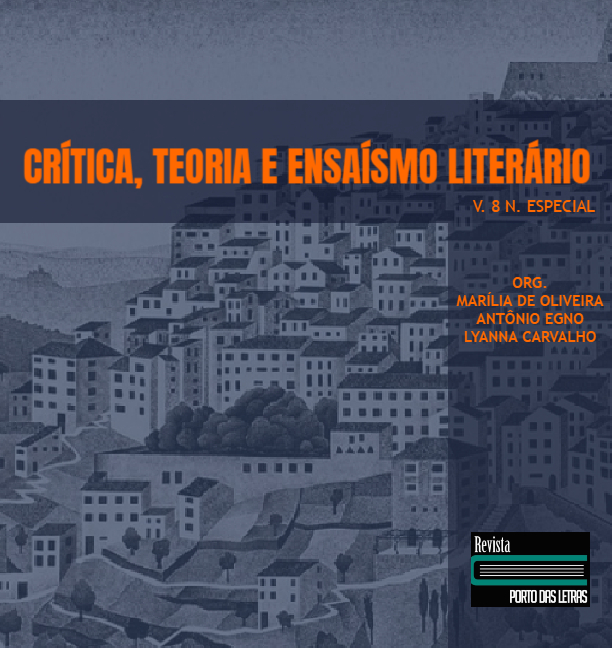From Infelicity to Infidelity
The Female Adultery in Madame Bovary by Gustave Flaubert
Keywords:
Flaubert, Madame Bovary, female adulteryAbstract
This article aims to analyze the novel Madame Bovary by the French writer Gustave Flaubert, considered the pioneer of the Realism. Based on an intrinsic vision, that is, on an Interpretation Oriented Toward the Text (IOTE), we will see the facts that would explain the reasons why the protagonist Emma, raised surrounded by romantic books in a convent, even after getting married to a good and honest man, became an adulterer, and besides, why she wanted to have a higher living standard and got deep in debt. Now in an Interpretation Oriented Toward the Writer (IOPE), that is, in an extrinsic vision of the text, we will verify the motives that demonstrate, despite the disdain Flaubert felt for his bourgeois characters, the deep connection between the writer and his creations, especially Emma Bovary. It will also present concisely the subject of the adultery in the world literature, from the antiquity to the 19th century, also known as “the century of the adultery”.
References
BAUDELAIRE, C. Madame Bovary di Gustave Flaubert. In: FLAUBERT, G. Madame Bovary: Costumi di provincia. Traduzione Maria Luisa Spaziani. Ed. speciale. Milano: Mondadori, 2003.
Bíblia do Peregrino. Tradução Luís Alonso Schökel. 3ª. Ed. São Paulo: Paulus, 2017.
BOCCACCIO, G. Decamerão. Tradução Ivone C. Benedetti. Porto Alegre: L&PM, 2013.
BULFINCH, T. O livro da Mitologia: a idade da fábula. Tradução Luciano Alves Meira. 2ª. Ed. São Paulo: Martin Claret, 2015.
CARMO GOMES, A. E. “Há um autor neste romance?”: A voz, a ação e os apelos do autor metaficcional. 2014. 310 f. Tese (Doutorado) - Faculdade de Letras, Universidade Federal de Goiás, Goiânia, 2014.
CARPEAUX, O. M. Prefácio. In: FLAUBERT, G. Madame Bovary. Tradução Sérgio Duarte. Ed. especial. Rio de Janeiro: Nova Fronteira, 2017.
CASTEL, E. Cocodrilos en el Antiguo Egipto: Temidos y venerados. Disponível em: <https://historia.nationalgeographic.com.es/a/cocodrilos-antiguo-egipto-temidos-y-vene rados_12991/1>. Atualizado em 07 mar. 2019. Acesso em: 28 dez. 2020
CERVANTES, M. de. Don Quijote de La Mancha. Barcelona: Clarín, 2000.
DOMINGOS, A. C. M. Figurando Emma Bovary: Uma Leitura Íntima de Sua Representação em Flaubert e Chabrol. Caderno Seminal. Vol. 20, N. 20, p. 11-34, jul.-dez. 2013.
FLAUBERT, G. Correspondance: Deuxième Série (1850-1854). 7ª. Ed. Paris: Bibliothèque Charpentier, 1905.
FLAUBERT, G. Correspondance: Troisième Série (1854-1869). 3ª. Ed. Paris: Bibliothèque Charpentier, 1892.
FLAUBERT, G. Correspondance: Quatrième Série (1869-1880). Paris: Bibliothèque Charpentier, 1893.
FLAUBERT, G. Madame Bovary. Tradução Sérgio Duarte. Ed. especial. Rio de Janeiro: Nova Fronteira, 2017.
FONTANE, T. Effi Briest. Tradução Mário Luiz Frungillo. São Paulo: Estação Liberdade, 2013.
GAY, P. O anatomista fóbico: Gustave Flaubert em Madame Bovary. In: GAY, P. Represálias selvagens: Realidade e ficção na literatura de Charles Dickens, Gustave Flaubert e Thomas Mann. Tradução Rosaura Eichenberg. São Paulo: Companhia das Letras, 2010. Sem paginação (Kindle/Amazon.com.br).
HAWTHORNE, N. A letra escarlate. Tradução Christian Schwartz. São Paulo: Penguin Companhia, 2011.
HOMERO. Ilíada. Tradução Octávio Mendes Cajado. São Paulo: DIFEL, 1961.
HOMERO. Odisseia. Tradução Trajano Vieira. 3ª. Ed. São Paulo: Editora 34, 2014.
KIERKEGAARD, S. A. O conceito de angústia. Disponível em: <http://filosofia.com. br/figuras/livros_inteiros/246.txt>. Acesso em: 02 dez. 2020.
LECLERC, Y. “Madame Bovary, c’est moi”, formule apocryfe. Disponível em: <https://flaubert.univ-rouen.fr/ressources/mb_cestmoi.php#:~:text=La%20phrase%20pr %C3%AAt%C3%A9e%20%C3%A0%20Flaubert,autre%2C%20une%20autre%20est20moi>. Acesso em: 12 jan. 2021.
LUPERINI, R. L’adulterio nel romanzo. Disponível em: <https://www.laletteraturaenoi. it/index.php/interpretazione-e-noi/232-1-adulterio-nel-romanzo.html>. Acesso em: 20 dez. 2020.
MORTON, A. Diana: sua verdadeira história em suas próprias palavras. Tradução A. B. Pinheiro de Lemos e Lourdes Sette. Rio de Janeiro: Best Seller, 2013.
PROUST, M. Contre Sainte-Beuve: notas sobre crítica e literatura. Tradução Haroldo Ramazini. São Paulo: Iluminuras, 1988.
RIBEIRO, M. “Emma Bovary sou eu”: Madame Bovary e o processo contra Flaubert. Disponível em: <https://www.sul21.com.br/breaking-news/2016/02/emma-bovary-sou-eu-madame-bovary-e-o-processo-contra-flaubert/>. Acesso em: 20 dez. 2020.
SAINTE-BEUVE. C.-A. Causeries du Lundi: Madame Bovary par Gustave Flaubert. Disponível em: <https://flaubert.univ-rouen.fr/etudes/madame_bovary/mb_sai.php>. Acesso em: 31 dez. 2020.
SHAKESPEARE, W. The Complete Works of William Shakespeare. San Diego: Canterbury Classic, 2014.
SIN-LÉQI-UNNÍNNI. Ele que o abismo viu: Epopeia de Gilgámesh. Tradução Jacyntho Lins Brandão. Belo Horizonte: Autêntica, 2018.
THIBAUDET, A. Introduzione. In: FLAUBERT, G. Madame Bovary: Costumi di provincia. Traduzione Maria Luisa Spaziani. Ed. speciale. Milano: Mondadori, 2003.
TOLSTÓI, L. Anna Kariênina. Tradução Rubens Figueiredo. São Paulo: Companhia das Letras, 2017.
WOOD, J. How Fiction Works. New York: Picador, 2008.
Downloads
Published
How to Cite
Issue
Section
License
Os autores concordam com os termos da Declaração de Direito Autoral, que se aplicará a esta submissão caso seja publicada nesta revista (comentários ao editor podem ser incluídos a seguir).

